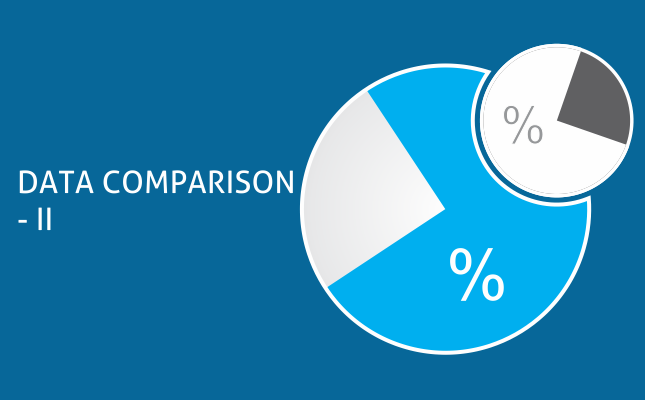
The previous article in the series "Data Comparison-I" explained the fundamentals of Data Comparison with solved illustrations and practice questions. In this article, we will plunge a step forward to take on the advanced questions on Data Comparison. These illustrations will be a direct application of the strategy tips learnt in Data Comparison-I article.
Data Comparison Question in Data Interpretation
As we know, each Data Comparison question consists of two quantities; one in column A and another is column B. Using your knowledge of mathematics, you have to decide the data given in which column is higher, and mark the option accordingly.
Usually the options in most of the competitive examinations are
A. If the quantity in column A is higher B. If the quantity in column B is higher C. If the two quantities are equal D. If the relationship cannot be establishedNote 1
Do not mark choice (D), if both columns contain only numbers or if you can demonstrate two different relationships between the columns.
Let us look through some solved questions to understand advance concepts.
Data Comparison Solved questions
Directions: Using the options given above, solve the following questions.
Example 1: Compare the two columns:
| Column A | Column B |
| The circumference of a circle with radius 2 | The sum of the circumferences of two circles, each with radius 1 |
Solution: Circumference of circle = 2 × 3.14 × r,
So, for r = 2, C1 = 2 × 3.14 × 2 = (4 × 3.14). For, r = 1, C2 = 2 × 3.14 × 1. For two circles of this type, 2C2 = (2 × 3.14 + 2 × 3.14) => 4 × 3.14. As we get the same result from both the columns, hence the answer is option (C).Example 2: Compare the two columns, given y represents the sum of the first 10 positive integers.
| Column A | Column B |
| 2y | 100 |
Solution: As we know, sum of first n positive integers = n(n+1)/2
Thus, y = sum of first ten positive integers = (10 × 11)/2 = 55 Now, Column A = 2 × 55 = 110 and Column B = 100 Since, Column A is greater than Column B. So, answer is option (A).Example 3:Compare the two columns given R, S and T are 3 consecutive odd integers.
| Column A | Column B |
| R + S + 1 | S + T - 1 |
Solution:This comparison can be easily made by assigning arbitrary values.
Let R = 1, then S = 3, T = 5 Now, Column A= R + S + 1 = 1 + 3 + 1 = 5. Column B = S + T - 1 = 3 + 5 - 1 = 7. Here, Column B is Greater. To cross check with a different set of values, let R = -1, then S = -3, T = - 5 Thus, Column A = R + S + 1 = -1 - 3 + 1 = -3. Column B = S + T - 1 = -3 - 5 - 1 = -9. Now, column A is greater. Since, no distinct relationship between the columns can be established, answer is option (D).Example 4: Compare the two columns.
| Column A | Column B |
| The number of ways that 6 can be expressed as a product of two different one-digit integers | The number of ways that 12 can be expressed as a product of two different one-digit integers |
Solution:By inferring each statement,
Column A: 6 can be expressed as 6 × 1 and 2 × 3. (2 ways) Column B: 12 can be expressed as 12 × 1, 6 × 2 and 3 × 4 (3 ways). But out of that, 12 × 1 contains a two-digit number. As that is not to be considered, the valid number of ways becomes 2. Thus, in both the cases, the valid number of cases becomes 2. Hence, the answer is option (C).Data Comparison: Key Learning
Do you still have a query regarding any concept or question, don't hesitate. Ask your doubt in the comments section below.